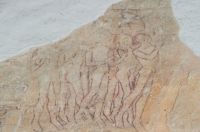
The oldest part of the church is likely the west doorway, set into the wall of the tower. This round-arched door is probably 12th century. The tower has had a stair turret of brick inserted during the 16th century.
The nave has a beautiful hammerbeam roof of 10 bays. This was probably decorated with carved figures when new, but there are no remaining figures now; they were probably destroyed in the Reformation. Despite the missing figures, the roof is nicely carved and brightly painted to create a very pleasing effect.

The rood screen has been much restored, in part by the famed Victorian architect William Butterfield; it was not even a rood screen to start with but acted to enclose a chapel in the south aisle. The octagonal font dates to 1500, and there are several attractive wooden pews boasting beautifully carved poppyhead ends and buttress figures.
Among these carved figures is a very lifelike carving of a dog, as well as a churchman and a lion. The carving is simply wonderful, and very striking.
Over the chancel arch is a faded 15th-century Doom wall painting. The centre of this painting has disappeared, but the sides are still quite clear. To the left, a group of figures including royalty and clergymen emerge from their graves and cluster at the gates of Heaven, where they are met by St Peter. To the right, another, less fortunate group of souls in Hell, where at least one is carted away in a wheelbarrow by a demon.
Behind the pulpit is a painted memorial to Thomas (d. 1702) and Dorothy Smyth (d. 1728). Compare the style of this painted monument to those of another couple, George and Jane Pretyman, at the west end, where each is commemorated in a classical cartouche.
St Mary the Virgin, Bacton is a very satisfying church to visit, and well worth taking the time to explore.
Note: Don't confuse this Bacton in Suffolk with the coastal Norfolk village of the same name.












 We've 'tagged' this attraction information to help you find related historic attractions and learn more about major time periods mentioned.
We've 'tagged' this attraction information to help you find related historic attractions and learn more about major time periods mentioned.




